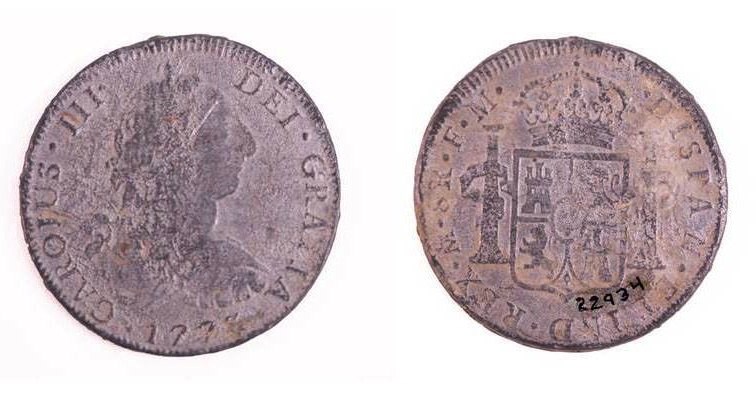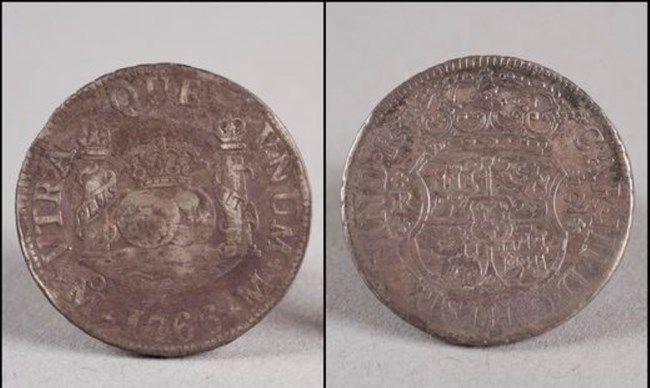Part of a series of articles titled Curious Collections of Fort Stanwix, The Oneida Carry Era.
Previous: Bone Buttons & Manufacturing Tool
Article

National Park Service
Artifacts from the past carry a historical value much greater than their original worth. For example, decks of playing cards are dime a dozen to us today. If we learn a deck was played with by U.S. soldiers in World War I, however, it suddenly accrues significant value. But what if we are talking about actual, historic currency, such as the handful of Spanish coins in the Fort Stanwix museum collection? In total, there were 51 various coins found in archeological excavations. Approximately 8 of them are Spanish. The majority were found in the remains of soldiers' barracks. The oldest Spanish coin dates to 1699. And the only coin in the collection that was minted during the American Revolution is Spanish as well!
The silver 8-reales Spanish coin in the image above, was minted in Mexico City in either 1773 or 1777. It depicts King Charles (Carolus) III of Spain on the face and a Spanish coat of arms with lions and castles bordered by pillars on the back. It was recovered at the park in 1998 and is a now a part of the park’s collection.

National Park Service
Spanish coins, like the 2-reale piece on the right, would have been very common as a universal currency, since the British colonists could not mint their own coinage and frequently ran out. As there were mints in Mexico City, Mexico, Spanish currency was readily in circulation and easily obtained through trade in the West Indies. For the new American nation, there was no monetary reserve waiting for pay the Continental Army. So soldiers were paid in "Continental Dollars," or paper promisary notes. On each was written the amount of "Spanish milled" (or hard) currency it could be exchanged for at a later date.
Spanish currency in the new world was based on the 8-reale Spanish dollar, also known as the piece-of-eight. The 8-reale pieces were sometimes split into eight actual pieces of a whole piece of eight, if things weren’t complicated enough. In 1770, a Spanish 2-reale was worth approximately 1 shilling and 1 pence in the colonies. That’s equal to just under 5 British pounds today (Hint: there were 20 shillings in a pound, meaning the currency inflated nearly 10,000%)!
The "milled" part of "Spanish milled" currency refered to the ridged edges that made it difficult for less honest folks to cheat other by actually shaving the valuable silver off of the coins. If the ridges were flattened or missing, it meant your currency was not complete. This clever design made Spanish coinage the preferred currency in trade world-wide. Even though the U.S. Dollar became the offical currency of the American nation in 1785, it wasn't until 1857 that the "Coinage Act" outlawed the use of Spanish money for official transactions.

National Park Service
Hanson, Lee M. Casemates and Cannonballs: Archaeological Investigations at Fort Stanwix, Rome, New York. Washington: National Park Service, 1975.
Part of a series of articles titled Curious Collections of Fort Stanwix, The Oneida Carry Era.
Previous: Bone Buttons & Manufacturing Tool
Last updated: October 20, 2022